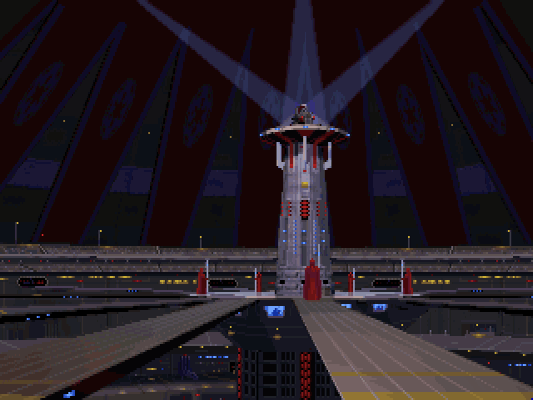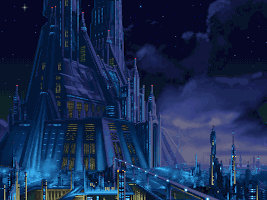HistoryThe Imperial Palace was originally called the Presidential Palace or the Palace of the Republic when it was used by the President of the Galactic Republic and as a complex of offices for its Senate.
Darth Vader kneels before the Emperor within the interior of the Imperial Palace. The Imperial Palace was the residence of Emperor Palpatine during his reign over the Galactic Empire. He drastically rebuilt the Palace into a massive complex that became the tallest building on Coruscant.
Structure and featuresImperial Palace looked like a hybrid of a cathedral and a monumental pyramid, and bore much resemblance to a Sith Temple. Palpatine's redesigned palace had a total height of three kilometers, making it the tallest building on Coruscant. Beneath the structure of the Palace were a series of chambers that held the Imperial Information Center. There was also a facility used to train Emperor's Hands.
The Palace was made of polished gray-green rock and mirrored crystals. Even at night, the Palace never grew dark since blazing illumination from phosphorescent panels, glowspheres, and electroluminescence strips kept the structure in a shower of blazing light. The Palpatine Gardens were located on the grounds of the Palace.
The Grand Corridor, its centerpiece, featured high ceilings and cutglass windows. Designed by the Emperor himself, it was said to have open areas large enough to accommodate a Victory-class Star Destroyer.
The Palace by night.Lining the main chamber were Ch'hala trees, which would continuously change color at sound vibrations. These trees were part of a spy system used by Emperor Palpatine, and later, Grand Admiral Thrawn, known as Delta Source. Above the Grand Corridor were cafes situated on balconies with a view of the busy streets below.
The Imperial Palace had its own Senate Chamber that resembled the old Senate Building. It had six hundred, six-person repulsorlift booths outlined in crimson upholstry.
All of the residential floors of the Palace contained extensive libraries. Guests were housed within the Chancellor's Guest Floor, which had previously been part of the Palace of the Republic that had been absorbed by the larger Palace structure. The Guest Floor was done in hand carved Fijisi wood.
The Palace contained over twenty thousand rooms and chambers in fifty connected structures. The people who worked there were expected to have a comlink at all times, because it was so easy to get lost. There were multiple tales of people getting lost in the Palace and never being seen again, and at least one, Frona Zeffla, died at her desk and was not found for at least one standard year.
It is possible that Palpatine or other high-ranking Imperials covered up unofficial executions as similar disappearances, but those theories were never confirmed. Emperor Palpatine was also said to have encouraged children of workers to play Hunter, a hide and seek like game, while their parents were working. Some games were said to have lasted for days.
Director of Imperial Intelligence Ysanne Isard's office was located in the Palace, as was a small Intelligence prison complex.
The Palace by day.Numerous architectural styles and design motifs could be found all over the Palace. In some areas, the structure was open and airy, with much illumination and transparisteel while others were dark with carved friezes on the ceiling. The walls of the Palace were made from cortosis, and its flooring included Wayland marble tiles.
At the highest tower of the Imperial Palace was the Emperor's throne room. It was a sunken auditorium, similar to a large crater, dug into bedrock. On the audience decks, there were flat stone benches arranged in long arcs, where visitors could come to hear any pronouncements from the Emperor himself.
What was unique about this chamber was that the audience could hear everything the Emperor said; the Emperor was also able to hear anything said to him from the audience decks. The slanted ceiling of the room was surrounded by gigantic purple and red Imperial banners. At the pinnacle of the throne room was an angled, prismatic skylight that poured rays of light onto Emperor Palpatine in his seat. Around the bottom of the tower at all time were six Emperor's Royal Guards protecting the Emperor.
Emperor Palpatine on his throne in the Palace's throne room.This was Emperor Palpatine's favorite throne room, as well as the most important one. The throne room was located on the highest tower of the Imperial Palace, overlooking all of Coruscant.
There was a blast-shielded war room located in the middle of the second floor. Adjacent to the war room was the Crypt, a computer slicing and decoding area. One wing of the palace contained a medical area, which under the New Republic was used to accommodate water-loving Mon Calamari. The wing resembled a coral reef, and an enclosed pool containing protoplasmic glurpfish and other sea life.
An information center for tourists was located on one of the decks that jutted out from the Palace during the time of the New Republic. Brochure droids and sculptures that had been fitted with speakers were used to allow tourists to access information regarding shuttle departure times, lodgings, eating establishments, and guided tours.
The Imperial Palace also included treasuries (including one treasury said to have been built by the legendary "pirate general" Toleph-Sor and hidden vaults containing Jedi and Sith artifacts), pavilions, prisons, music rooms, and both summer and winter quarters. It also had a private aviary of hawk-bats, so that the Emperor and selected guests could have hawk-bat meat or eggs at their leisure.
Palace securityDuring the Imperial era, the Palace was guarded by a regiment of stormtroopers, as well as the Emperor's Royal Guard and Imperial Intelligence operatives. However, Palace security was independent of the Coruscant Security Force, the head of which had no jurisdiction over the Palace.
Behind the scenesDark Forces II: Jedi Knight image of what appears to be the Imperial Palace on Coruscant.The Imperial Palace was first introduced, along with the rest of Coruscant, in Timothy Zahn's Heir to the Empire novel, though its origins date back to rough drafts of Return of the Jedi.
Some fans have gained the erroneous impression that the Palace was seen in the scene of the Uprising on Coruscant in the re-released version of Return of the Jedi, but the Palace has, in fact, never appeared in any of the films.
Some depictions of the Imperial Palace are non-pyramidal in shape, including the palaces shown in Star Wars: Galactic Battlegrounds, Star Wars: Empire at War, Star Wars: Rebellion, and Dark Forces II: Jedi Knight. These depictions may either be non-canonical, or simply depict one of the structures in the Palace complex other than the main pyramid.







